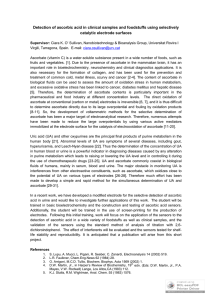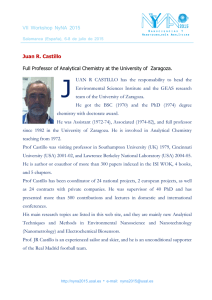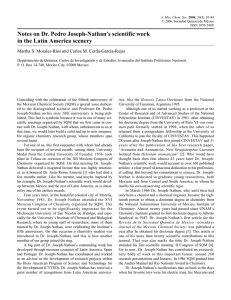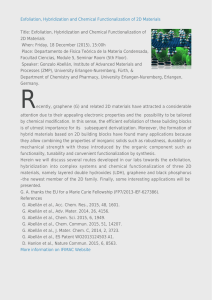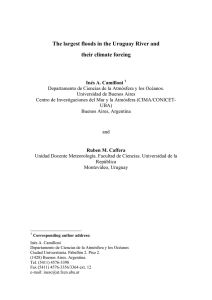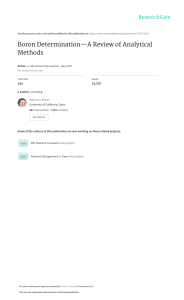Analytical Chemistry in Uruguay: A review (2000 – 2012)
Anuncio
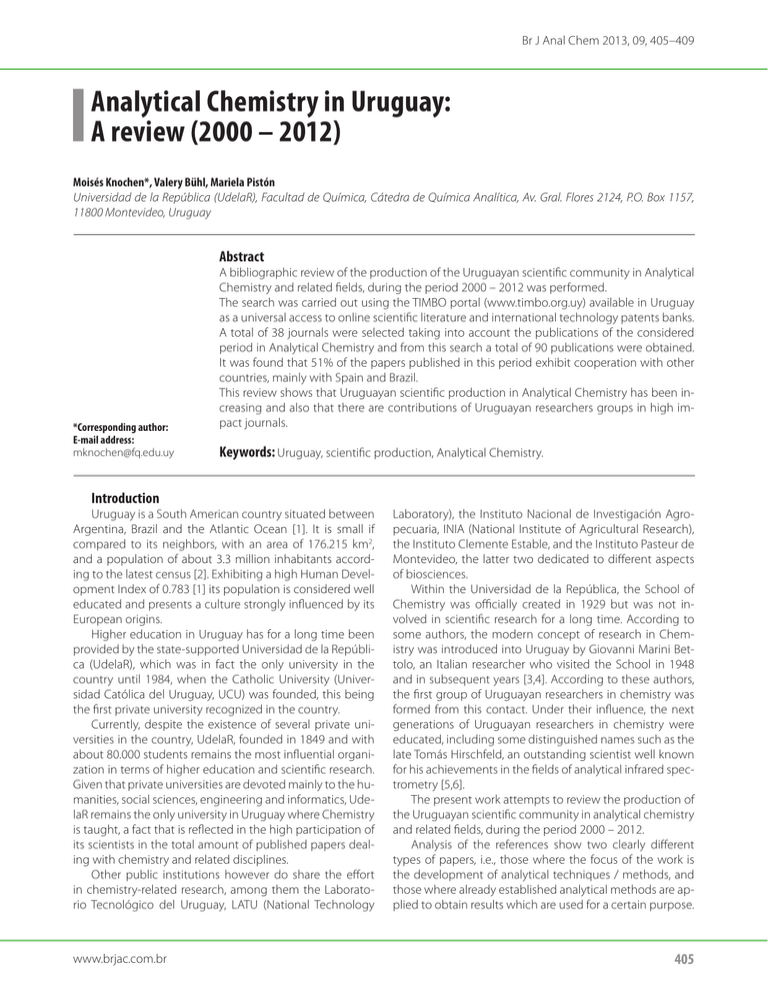
Br J Anal Chem 2013, 09, 405–409 Analytical Chemistry in Uruguay: A review (2000 – 2012) Moisés Knochen*, Valery Bühl, Mariela Pistón Universidad de la República (UdelaR), Facultad de Química, Cátedra de Química Analítica, Av. Gral. Flores 2124, P.O. Box 1157, 11800 Montevideo, Uruguay Abstract *Corresponding author: E-mail address: [email protected] A bibliographic review of the production of the Uruguayan scientific community in Analytical Chemistry and related fields, during the period 2000 – 2012 was performed. The search was carried out using the TIMBO portal (www.timbo.org.uy) available in Uruguay as a universal access to online scientific literature and international technology patents banks. A total of 38 journals were selected taking into account the publications of the considered period in Analytical Chemistry and from this search a total of 90 publications were obtained. It was found that 51% of the papers published in this period exhibit cooperation with other countries, mainly with Spain and Brazil. This review shows that Uruguayan scientific production in Analytical Chemistry has been increasing and also that there are contributions of Uruguayan researchers groups in high impact journals. Keywords: Uruguay, scientific production, Analytical Chemistry. Introduction Uruguay is a South American country situated between Argentina, Brazil and the Atlantic Ocean [1]. It is small if compared to its neighbors, with an area of 176.215 km2, and a population of about 3.3 million inhabitants according to the latest census [2]. Exhibiting a high Human Development Index of 0.783 [1] its population is considered well educated and presents a culture strongly influenced by its European origins. Higher education in Uruguay has for a long time been provided by the state-supported Universidad de la República (UdelaR), which was in fact the only university in the country until 1984, when the Catholic University (Universidad Católica del Uruguay, UCU) was founded, this being the first private university recognized in the country. Currently, despite the existence of several private universities in the country, UdelaR, founded in 1849 and with about 80.000 students remains the most influential organization in terms of higher education and scientific research. Given that private universities are devoted mainly to the humanities, social sciences, engineering and informatics, UdelaR remains the only university in Uruguay where Chemistry is taught, a fact that is reflected in the high participation of its scientists in the total amount of published papers dealing with chemistry and related disciplines. Other public institutions however do share the effort in chemistry-related research, among them the Laboratorio Tecnológico del Uruguay, LATU (National Technology www.brjac.com.br Laboratory), the Instituto Nacional de Investigación Agropecuaria, INIA (National Institute of Agricultural Research), the Instituto Clemente Estable, and the Instituto Pasteur de Montevideo, the latter two dedicated to different aspects of biosciences. Within the Universidad de la República, the School of Chemistry was officially created in 1929 but was not involved in scientific research for a long time. According to some authors, the modern concept of research in Chemistry was introduced into Uruguay by Giovanni Marini Bettolo, an Italian researcher who visited the School in 1948 and in subsequent years [3,4]. According to these authors, the first group of Uruguayan researchers in chemistry was formed from this contact. Under their influence, the next generations of Uruguayan researchers in chemistry were educated, including some distinguished names such as the late Tomás Hirschfeld, an outstanding scientist well known for his achievements in the fields of analytical infrared spectrometry [5,6]. The present work attempts to review the production of the Uruguayan scientific community in analytical chemistry and related fields, during the period 2000 – 2012. Analysis of the references show two clearly different types of papers, i.e., those where the focus of the work is the development of analytical techniques / methods, and those where already established analytical methods are applied to obtain results which are used for a certain purpose. 405 Analytical Chemistry in Uruguay: A review (2000 – 2012) Most of the papers can be classified as belonging to the second type, perhaps reflecting an early stage in the evolution of the analytical community. Concerning the analytical techniques used, a significant number of papers deal with separation techniques such as gas and liquid chromatography, generally associated with selective detection techniques such as MS [7-37]. Many of these papers originate in research groups engaged in the determination of pesticides in food and other matrices. Spectrochemical techniques are widely used, appearing frequently in the publications, with special emphasis on atomic spectrometry (AAS, ICP-OES, ICP-MS) [38-52] and near infrared (NIR) spectrometry [53-62], the latter applied to the analysis of different types of foods. Flow analysis and automation is a consolidated research line in Uruguay, and papers on these subjects appear frequently. Several techniques such as flow injection analysis (FIA) [63-70], multicommutated flow analysis (MCFA) [71-76] and sequential injection analysis (SIA) [77-80] have been used for the determination of organic and inorganic analytes. Several papers dealing with the flow analysis of lubricating oils also show a specific application of these techniques [63, 67, 68, 69, 71]. Lately, new research lines have evolved, focusing on the development of different types of biosensors based on the use of nanoparticles and electrochemical detection [81-85]. Some interesting experiments for teaching analytical chemistry in university laboratories were published in educational journals [86-88]. Other techniques involve the use of immunoassays, spectrofluorimetry, NMR and chemometrics among other miscellaneous topics [89-97]. Methodology The search was performed using the TIMBO portal (http://www.timbo.org.uy/) available in Uruguay as a universal access to online scientific literature and international technology patents banks. Scopus was the main bibliographic database consulted, along with Scirus and Google Scholar. A total of 38 journals were selected taking into account the publications of about the last ten years in Analytical Chemistry. The selected journals were: Journal of Agricultural and Food Chemistry, Talanta, Meat Science, Analytical and Bioanalytical Chemistry, Biosensors and Bioelectronics, Journal of Chromatography A, Agricultura Técnica, Journal of Chemical Education, Environmental Geochemistry and Health, Journal of Automated Methods and Management in Chemistry, Atomic Spectroscopy, Journal of Pharmaceutical and Biomedical Analysis, Journal of Food Composition and Analysis, Analytical Methods, Journal of Near Infrared Spectroscopy, Journal of Environmental Science and Health - Part B, Avances en Ciencias e Ingeniería, Journal of Chromatography B, Food Chemistry, Analytica Chimica 406 Acta, European Food Research and Technology, Analytical Chemistry, Applied Spectroscopy Reviews, Archives of Environmental Contamination and Toxicology, Atmospheric Environment, Bulletin of Environmental Contamination and Toxicology, Environmental Geology, International Journal of Environmental Research and Public Health, International Journal of Analytical Chemistry, Journal of Chromatographic Science, Journal of Electroanalytical Chemistry, Journal of Food Engineering, Livestock Production Science, Plant Physiology and Biochemistry, Soil &Tillage Research, Trends in Analytical Chemistry, Spectrochimica Acta B and Journal of the Science of Food and Agriculture. From this search a total of 90 publications were obtained. Results and Discussion The total population in Uruguay is 3.3 million inhabitants according to the latest census [2] and the number of researchers per million inhabitants increased from 277.7 in 2000 to 346 in 2008 [98], showing an important development of scientific research in the last decade. This is reflected in the increase of publications per year in the area of Analytical Chemistry, as shown in Figure 1, however it is still a small discipline in relation to the country’s scientific community. It is noteworthy that 51% of the papers published in the period considered correspond to work carried out in cooperation with other countries, mainly with Spain and Brazil. Distribution of the collaboration with other countries is shown in Figure 2. The search employing the TIMBO portal (www.timbo. org.uy) showed that the 78% of the publications were from Universidad de la República (UdelaR), which means that at least one of the authors belongs to the public university. Figure 1. Evolution of the number of papers published in the last decade Two of the most productive groups in terms of publications in Analytical Chemistry in the last five years are those devoted to the investigation of organic contaminants at trace levels in food, and to flavour analysis and enology. Br J Anal Chem Knochen et al. Hence the significant number of publications in journals such as the Journal of Agricultural and Food Chemistry, Journal of the Science of Food and Agriculture and Food Chemistry, among others. Figure 2. Cooperation with other countries in terms of publications in the last decade Publications produced by groups dedicated to analytical automation and development of flow analysis systems can be found mainly in Talanta and Journal of Automated Methods and Management in Chemistry and, to a lesser extent, in the Journal of Pharmaceutical and Biomedical Analysis, and Analytical Methods, among others. Other important research areas in Uruguay are related to environmental health, toxicology and electroanalytical chemistry. The distribution of the 90 selected publications is summarized in Table I. This distribution also shows an interesting number of publications in Meat Science, a fact that is in good agreement with the application of Analytical Chemistry in topics related with one of the main productive activities of the country. The same observation can be made regarding the publications in Agricultura Técnica. While the number of publications is not high in the last decade, the highest percentage of them were published in journals whose ISI impact factor goes from 2.275 to 5.602. This shows that high impact journals in Analytical Chemistry include the contribution of Uruguayan researchers. Table I. Publications in the selected journals Journal Percentage of publications Journal of Agricultural and Food Chemistry 14 Talanta 10 Meat Science 6 Analytical and Bioanalytical Chemistry 6 Biosensors and Bioelectronics 4 Journal of Chromatography A 4 Journal of Automated Methods and Management 4 in Chemistry Agricultura Técnica 3 Journal of Chemical Education 3 Environmental Geochemistry and Health 3 Atomic Spectroscopy 3 Journal of Pharmaceuticals and Biomedical 3 Analysis Journal of Food Composition and Analysis 3 Analytical Methods 2 Journal of Near Infrared Spectroscopy 2 Journal of Environmental Science and Health 2 Part B Avances en Ciencias e Ingeniería 2 Analytica Chimica Acta 1 European Food Research and Technology 1 Conclusions This review shows that while scientific production in Analytical Chemistry in Uruguay is still small when compared to other countries in the region, it has been increasing in the last 10 years. Also it can be concluded that many contributions of Uruguayan research groups are published in high impact journals. www.brjac.com.br Journal Journal of Chromatography B Analytical Chemistry Food Chemistry Applied Spectroscopy reviews Archives Environ. Contam. Toxicol Atmospheric Environment Percentage of publications 1 1 1 1 1 1 Bulletin of Environmental Contamination toxicology 1 Environmental Geology 1 International Journal of Environmental Research and Public Health 1 International Journal of Analytical Chemistry Journal Chromatographic Science Journal of Electroanalytical Chemistry Journal of Food Engineering Livestock Production Science Plant Physiology and Biochemistry Soil & Tillage Research TrAC Trends in Analytical Chemistry Spectrochimica Acta B Journal of the Science of Food and Agriculture 1 1 1 1 1 1 1 1 1 1 Considering that research and development in Analytical Chemistry relies heavily on the investment in modern instrumentation, it can be hoped that the creation in 2005 of the National Agency for Research and Innovation (ANII) will have a significant impact reflected in a sustained growth and improvement in scientific production in this area. 407 Analytical Chemistry in Uruguay: A review (2000 – 2012) References 1. http://en.wikipedia.org/wiki/Uruguay, accessed October 2012. 2. Instituto Nacional de Estadística (Uruguay), “Resultados del Censo de Población 2011: población, crecimiento y estructura por sexo y edad”. http://www.ine.gub.uy/censos2011/resultadosfinales/analisispais.pdf, accesed October 2012. 3. Moyna P.; Chem. Int. 2004, 26 4. Borkenztain, B.; Davyt, F. ; Ferreira, F.; Moyna, P.; Hist. cienc. saude-Manguinhos, 2005, 12, 535. 5. Shapiro, H.M.; Cytometry 1986, 7, 399. 6. Grasselli, J. G.; Mikrochim. Acta 1987, 3, 13. 7. Báez, H.; Camargo, C.; Osorio, H.; Umpiérrez, F.; J. Chromatogr. Sci. 2004, 42, 551. 8. Fariña, L.; Boido, E.; Carrau, F.; Versini, G.; Dellacassa, E.; J. Agric. Food Chem. 2005, 53, 1633. 9. Boido, E.; Alcalde-Eon, C.; Carrau, F.; Dellacassa, E.; Rivas-Gonzalo, J.C.; J. Agric. Food Chem. 2006, 54, 6692. 10. Cabrera, M.C.; Saadoun, A.; Grompone, A.; Pagano, T.; Salhi, M.; Olivero, R.; del Puerto, M.; Food Chem. 2006, 98, 767. 11. Versini, G.; Camin, F.; Ramponi, M.; Dellacassa, E.; Anal. Chim. Acta 2006, 563, 325. 12. Escudero, A.; Campo, E.; Fariña, L.; Cacho, J.; Ferreira, V.; J. Agric. Food Chem. 2007, 55, 4501. 13. González-Neves, G.; Franco, J.; Barreiro, L.; Gil, G.; Moutounet, M.; Carbonneau, A.; Eur. Food Res. Technol. 2007, 225, 111. 14. Gerpe, A.; Merlino, A.; Boiani, M.; Porcal, W.; Fagiolino, P.; González, M.; Cerecetto, H.; J. Pharm. Biomed. Anal. 2008, 47, 88. 15. Kmellár, B.; Fodor, P.; Pareja, L.; Ferrer, C.; Martínez-Uroz, M.A.; Valverde, A.; Fernandez-Alba, A.R.; J. Chromatogr., A 2008, 1215, 37. 16. Boido, E.; Medina, K.; Fariña, L.; Carrau, F.; Versini, G.; Dellacassa, E.; J. Agric. Food Chem. 2009, 57, 6271. 17. De la Fuente, J.; Díaz, M.T.; Álvarez, I.; Oliver, M.A.; Font i Furnols, M.; Sañudo, C.; Campo, M.M.; Montossi, F.; Nute, G.R. Cañeque, V.; Meat Sci. 2009, 82, 331. 18. Irazoqui, G.; Giacomini, C.; Batista-Viera, F.; Brena, B.M.; CardelleCobas, A.; Corzo, N.; Jimeno, M.L.; J. Agric. Food Chem. 2009, 57, 11302. 19. Ferrer, C.; Mezcua, M.; Martínez-Uroz, M.A.; Pareja, L.; Lozano, A.; Fernández-Alba, A.R.; Anal. Bioanal. Chem. 2010, 398, 2299. 20. González-Neves, G.; Gil, G.; Barreiro, L.; Favre, G.; J. Food Compos. Anal. 2010, 23, 447. 21. Pérez-Parada, A.; González, J.; Pareja, L.; Geis-Asteggiante, L.; Colazzo, M.; Niell, S.; Besil, N.; González, G.; Cesio, V.; Heinzen, H.; J. Environ. Sci. Health, Part B 2010, 45, 830. 22. Resconi, V.C.; Campo, M.M.; Montossi, F.; Ferreira, V.; Sañudo, C.; Escudero, A.; Meat Sci. 2010, 85, 700. 23. Galietta, G.; Egaña, E.; Gemelli, F.; Maeso, D.; Casco, N.; Conde, P.; Nuñez, S.; J. Environ. Sci. Health, Part B 2011, 46, 35. 24. Geis-Asteggiante, L.; Lehotay, S.J.; Fortis, L.L.; Paoli, G.; Wijey, C.; Heinzen, H.; Anal. Bioanal. Chem. 2011, 401, 2617. 25. Gómez-Ramos, M.D.M.; Pérez-Parada, A.; García-Reyes, J.F.; Fernández-Alba, A.R.; Agüera, A.; J. Chromatogr., A 2011, 1218, 8002. 26. Jones, J.; Magri, R.; Rios, R.; Jones, M.; Plate, C.; Lewis, D.; Anal. Methods 2011, 3, 1310. 27. Kmellár, B.; Pareja, L.; Ferrer, C.; Fodor, P.; Fernández-Alba, A.R.; Talanta 2011, 84, 262. 28. Niell, S.; Pareja, L.; González, G.; González, J.; Vryzas, Z.; Cesio, M.V.; Papadopoulou-Mourkidou, E.; Heinzen, H.; J. Agric. Food Chem. 2011, 59, 7601. 29. Pareja, L.; Cesio, V.; Heinzen, H.; Fernández-Alba, A.R.; Talanta 2011, 83, 1613. 30. Pareja, L.; Colazzo, M.; Pérez-Parada, A.; Niell, S.; Carrasco-Letelier, L.; Besil, N.; Cesio, M.V.; Heinzen, H.; Int. J. Environ. Res. Public 408 Health 2011, 8, 3844. 31. Pareja, L.; Fernández-Alba, A.R.; Cesio, V.; Heinzen, H.; TrAC, Trends Anal. Chem. 2011, 30, 270. 32. Pareja, L.; Martínez-Bueno, M.J.; Cesio, V.; Heinzen, H.; Fernández-Alba, A.R.; J. Chromatogr., A 2011, 1218, 4790. 33. Pérez-Parada, A.; Colazzo, M.; Besil, N.; Geis-Asteggiante, L.; Rey, F.; Heinzen, H.; J. Chromatogr., A 2011, 1218, 5852. 34. Silva, V.; Genta, G.; Möller, M.N.; Masner, M.; Thomson, L.; Romero, N.; Radi, R.; Fernandes, D.C.; Laurindo, F.R.M.; Heinzen, H.; Fierro, W.; Denicola, A.; J. Agric. Food Chem. 2011, 59, 6430. 35. Pareja, L.; Colazzo, M.; Pérez-Parada, A.; Besil, N.; Heinzen, H.; Böcking, B.; Cesio, V.; Fernández-Alba, A.R.; J. Agric. Food Chem. 2012, 60, 4440. 36. Rivero, A.; Niell, S.; Cesio, V.; Cerdeiras, M.P.; Heinzen, H.; J. Chromatogr., B: Anal. Technol. Biomed. Life Sci. 2012, 907, 168. 37. Verza, S.G.; Silveira, F.; Cibulski, S.; Kaiser, S.; Ferreira, F.; Gosmann, G.; Roehe, P.M.; Ortega, G.G.; J. Agric. Food Chem. 2012, 60, 3113. 38. Méndez, E.; Giudice, H.; Pereira, A.; Inocente, G.; Medina, D.; J. Food Compos. Anal. 2001, 14, 453. 39. Méndez, E.; Giudice, H.; Pereira, A.; Inocente, G.; Medina, D.; J. Food Compos. Anal. 2001, 14, 547. 40. Pignalosa, G.; Cabrera, N.; Mollo, A.; Portillo, I.; Rouco, V.; Vázquez, L.; Spectrochim. Acta, Part B 2001, 56, 1995. 41. Zunckel, M.; Saizar, C.; Zarauz, J.; Atmos. Environ. 2003, 37, 1601. 42. Cousillas, A.Z.; Mañay, N.; Pereira, L.; Alvarez, C.; Coppes, Z.; Bull. Environ. Contam. Toxicol. 2005, 75, 629. 43. Torre, M.H.; Viera, I.; Facchin, G.; Kremer, E.; Baran, E.J.; Porochin, T.; DiDonato, V.; Irigoyen, C.; Irigoyen, J.; Saldanha, S.; Bussi, J.; Ohanian, M.; Fuentes, J.; Livest. Prod. Sci. 2005, 95, 49. 44. Viana, F.; Huertas, R.; Danulat, E.; Arch. Environ. Contam. Toxicol. 2005, 48, 530. 45. Rivero-Huguet, M.; Huertas, R.; Francini, L.; Vila, L.; Darré, E.; At. Spectrosc. 2006, 27, 48. 46. Manganelli, A.; Goso, C.; Guerequiz, R.; Fernández Turiel, J.L.; García Vallès, M.; Gimeno, D.; Pérez, C.; Environ. Geol. 2007, 53, 827. 47. Goenaga-Infante, H.; Sturgeon, R.; Turner, J.; Hearn, R.; Sargent, M.; Maxwell, P.; Yang, L.; Barzev, A.; Pedrero, Z.; Cámara, C.; Díaz Huerta, V.; Fernández Sánchez, M.L.; Sanz-Medel, A.; Emese, K.; Fodor, P.; Wolf, W.; Goldschmidt, R.; Vacchina, V.; Szpunar, J.; Valiente, L.; Huertas, R.; Labarraque, G.; Davis, C.; Zeisler, R.; Turk, G.; Rizzio, E.; MacKay, L.G.; Myors, R.B.; Saxby, D.L.; Askew, S.; Chao, W.; Jun, W.; Anal. Bioanal. Chem. 2008, 390, 629. 48. Ramos, A.; Cabrera, M.C.; del Puerto, M.; Saadoun, A.; Meat Sci. 2009, 81, 116. 49. Cabrera, M.C.; Ramos, A.; Saadoun, A.; Brito, G.; Meat Sci. 2010, 84, 518. 50. Cousillas, A.; Pereira, L.; Heller, T.; Alvarez, C.; Mañay, N.; Environ. Geochem. Health 2012, 34, 207. 51. Míguez, D.M.; Huertas, R.; Carrara, M.V.; Carnikián, A.; Bouvier, M.E.; Martínez, M.J.; Keel, K.; Pioda, C.; Darré, E.; Pérez, R.; Viera, S.; Massa, E.; Environ. Geochem. Health 2012, 34, 199. 52. Ramos, A.; Cabrera, M.C.; Saadoun, A.; Meat Sci. 2012, 91, 116. 53. Cozzolino, D.; Fassio, A.; Gimenez, A.; J. Sci. Food Agric. 2001, 81, 142. 54. Cozzolino, D.; Martins, V.; Murray, I.; J. Near Infrared Spectrosc. 2002, 10, 187. 55. Morón, A.; Cozzolino, D.; J. Near Infrared Spectrosc. 2002, 10, 215. 56. Cozzolino, D.; Chree, A.; Scaife, J.R.; Murray, I.; J. Agric. Food Chem. 2005, 53, 4459. 57. Cozzolino, D.; Delucchi, I.; Kholi, M.; Vázquez, D.; Agric. Tec. 2006, 66, 370. 58. Cozzolino, D.; Morón, A.; Soil Tillage Res. 2006, 85, 78. 59. Cozzolino, D.; Vadell, A.; Ballesteros, F.; Galietta, G.; Barlocco, N.; Anal. Bioanal. Chem. 2006, 385, 931. Br J Anal Chem Knochen et al. 60. Garcia, J.; Cozzolino, D.; Agric. Tec. 2006, 66, 41. 61. Cozzolino, D.; Fassio, A.; Restaino, E.; Fernandez, E.; La Manna, A.; J. Agric. Food Chem. 2008, 56, 79. 62. Cozzolino, D.; Corbella, E.; Smyth, H.E.; Appl. Spectrosc. Rev. 2011, 46, 523. 63. Pignalosa, G.; Knochen, M.; At. Spectrosc. 2001, 22, 250. 64. Knochen, M.; Giglio, J.; Reis, B.F.; J. Pharm. Biomed. Anal. 2003, 33, 191. 65. Dol, I.; Knochen, M.; Talanta 2004, 64, 1233. 66. Knochen, M.; Giglio, J.; Talanta 2004, 64, 1226. 67. Knochen, M.; Sixto, A.; Pignalosa, G.; Domenech, S.; Garrigues, S.; De La Guardia, M.; Talanta 2004, 64, 1359. 68. Pignalosa, G.; Knochen, M.; Cabrera, N.; J. Autom. Methods Manage. Chem. 2005, 2005, 1. 69. Pignalosa, G.; Sixto, A.; Knochen, M.; Talanta 2007, 73, 959. 70. Pistón, M.; Knochen, M.; Int. J. Anal. Chem. 2012, 2012, Article ID 918292, 1. 71. Reis, B.F.; Knochen, M.; Pignalosa, G.; Cabrera, N.; Giglio, J.; Talanta 2004, 64, 1220. 72. Knochen, M.; Pistón, M.; Salvarrey, L.; Dol, I.; J. Pharm. Biomed. Anal. 2005, 37, 823. 73. Pistón, M., Dol, I., Knochen, M.; J. Autom. Methods Manage. Chem. 2006, 2006, Article ID 47627, 1. 74. Pistón, M.; Silva, J.; Pérez-Zambra, R.; Knochen, M.; Anal. Methods 2009, 1, 139. 75. Sixto, A.; Knochen, M.; Talanta 2009, 77, 1534. 76. Pistón, M.; Silva, J.; Pérez-Zambra, R.; Dol, I.; Knochen, M.; Environ. Geochem. Health 2012, 34, 273. 77. Knochen, M.; Caamaño, A.; Bentos, H.; J. Autom. Methods Manag. Chem. 2011, 2011, Article ID 943465, 1. 78. Pistón M.; Knochen, M; Av. Cienc. Ing. 2011, 23, 57. 79. Pistón, M.; Mollo, A.; Knochen, M.; J. Autom. Methods Manag. Chem. 2011, 2011, Article ID 148183, 1 80. Sixto A; Knochen, M; Av. Cienc. Ing. 2011, 21, 71. 81. Lages, C.; Méndez, E.; Anal. Bioanal. Chem. 2007, 388, 1689. 82. Tosar, J.P.; Keel, K.; Laíz, J.; Biosens. Bioelectron. 2009, 24, 3036. www.brjac.com.br 83. Tosar, J.P.; Brañas, G.; Laíz, J.; Biosens. Bioelectron. 2010, 26, 1205. 84. Rodriguez-Emmenegger, C.; Avramenko, O.A.; Brynda, E.; Skvor, J.; Alles, A.B.; Biosens. Bioelectron. 2011, 26, 4545. 85. Arévalo, F.J.; González-Techera, A.; Zon, M.A.; González-Sapienza, G.; Fernández, H.; Biosens. Bioelectron. 2012, 32, 231. 86. Mahler, G.; Davyt, D.; Gordon, S.; Incerti, M.; Núñez, I.; Pezaroglo, H.; Scarone, L.; Serra, G.; Silvera, M.; Manta, E.; J. Chem. Educ. 2008, 85, 1652. 87. Moresco, H.; Sansón, P.; Seoane, G.; J. Chem. Educ. 2008, 85, 1091. 88. Botasini, S.; Luzuriaga, L.; Cerdá, M.F.; Méndez, E.; Ferrer-Sueta, G.; Denicola, A.; J. Chem. Educ. 2010, 87, 1011. 89. Rufo, C.; Hammock, B.D.; Gee, S.J., Last, J.A.; González-Sapienza, G.; J. Agric. Food Chem. 2004, 52, 182. 90. Echeverry, C.; Ferreira, M.; Reyes-Parada, M.; Abin-Carriquiry, J.A.; Blasina, F.; González-Neves, G.; Dajas, F.; J. Food Eng. 2005, 69, 147. 91. Dellavalle, P.D.; Dalla Rizza, M.; Vázquez, D.; Castro, M.; Agric. Tec. 2006, 66, 360. 92. Pasqua, G.; Silvestrini, A.; Monacelli, B.; Mulinacci, N.; Menendez, P.; Botta, B.; Plant Physiol. Biochem. 2006, 44, 220. 93. Nam, P.H.; Alejandra, B.; Frédéric, H.; Didier, B.; Olivier, S.; Pauss, A.; Talanta 2008, 76, 936. 94. Veiga, N.; Rivero-Huguet, M.; Huertas, R.; At. Spectrosc. 2008, 29, 63. 95. Muñoz, E.C.; Schrebler, R.S.; Grez, P.C.; Henríquez, R.G.; Heyser, C.A.; Verdugo, P.A.; Marotti, R.E.; J. Electroanal. Chem. 2009, 633, 113. 96. Carlomagno, M.; Mathó, C.; Cantou, G.; Sanborn, J.R.; Last, J.A.; Hammock, B.D.; Roel, A.; González, D.; González-Sapienza, G.; J. Agric. Food Chem. 2010, 58, 4367. 97. Rossotti, M.A.; Carlomagno, M.; González-Techera, A.; Hammock, B.D.; Last, J.; González-Sapienza, G.; Anal. Chem. 2010, 82, 8838. 98. http://search.worldbank.org/data?qterm=uruguay&language=ES, accessed December 2012. 409
